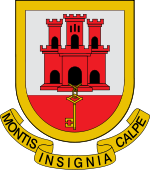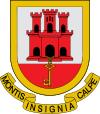- Coat of arms of Gibraltar
-
Coat of arms of Gibraltar 
Details Escutcheon Divided per fess:
2nd Division: One third Gules, a key of Or hanging by a chain also of Or from the castle.
1st Division: Two thirds Argent, a triple-towered castle of Gules, masoned and ajouré of Sable.Motto Latin: Montis Insignia Calpe
English: Of the mountain called CalpeUse 1502[citation needed] - Present The coat of arms of Gibraltar was first granted by a Royal Warrant passed in Toledo on July 10, 1502, by Isabella I of Castile during Gibraltar's Spanish period. The arms consists of an escutcheon and features a three-towered red castle under which hangs a golden key.
Contents
Heraldic description
 Arms granted to Gibraltar by Isabella I of Castile.
Arms granted to Gibraltar by Isabella I of Castile.
The arms were described in the Royal Warrant as consisting of:[1]
"...an escutcheon on which two thirds of its upper part shall have a white field; in the said field set a red Castle; underneath the said Castle, on the other third of the escutcheon, which must be a red field in which there must be a white line between the Castle and the said red field; on this a golden key which shall be on that with a chain from the said castle..."
The arms consist of a shield parted per fess:
- 1st Division: Two thirds Argent, a triple-towered castle of Gules, masoned and ajouré of Sable.
- 2nd Division: One third Gules, a key of Or hanging by a chain also of Or from the castle.
The castle has its roots in the heraldry of the Kingdom of Castile, the largest and most important medieval Spanish kingdom, of which Isabella was Queen. The preamble to the warrant granting the coat of arms to Gibraltar said:[1]
"...and we, deeming it right, and acknowledging that the said City is very strong and by its situation it is the key between these our kingdoms in the Eastern and Western Seas and the sentinel and defence of the Strait of the said Seas through which no ships of peoples of either of these Seas can pass to the other without sighting it or calling at it."
The idea of Gibraltar being the key to Spain or the Mediterranean originated well before the Spanish conquest. The followers of Tariq ibn-Ziyad, who invaded Spain via Gibraltar in 711, are said to have adopted the symbol of the key when they settled in Granada.[2] The coat of arms was accompanied by the inscription "Seal of the noble city of Gibraltar, the Key of Spain".[3]
Use
 The coat of arms of the government of Gibraltar combines that of Her Majesty's Government and Gibraltar's own coat of arms.
The coat of arms of the government of Gibraltar combines that of Her Majesty's Government and Gibraltar's own coat of arms.
Today, the official coat of arms as used by the government of Gibraltar consists of the original coat of arms with the addition of the motto, Montis Insignia Calpe ("Insignia of the Mountain of Calpe", i.e., the Rock of Gibraltar), which was granted by the College of Arms[4] in 1836 to commemorate the 1779-83 Great Siege of Gibraltar.[5] It is the oldest coat of arms in use in an overseas territory of the United Kingdom and is unique in that it is the only armorial insignia that dates from before the period of British colonial administration.
The arms differ from the seal of Gibraltar, which is an image of the Rock of Gibraltar with a sailing ship in the forefront. There is no evidence available as to when this image was created. From 1982, a banner of the arms has been used as the flag of Gibraltar. The arms also appear in the flag of the governor of Gibraltar. The arms of the government of Gibraltar are the same as the royal coat of arms of the United Kingdom combined with a badge featuring the coat of arms of Gibraltar.
Variations
A very similar coat of arms is in use by the nearby Spanish municipality of San Roque, using a slightly different version of the same main heraldic elements (the escutcheon with the castle and key), with the addition of a Royal Crown above the escutcheon.
When Gibraltar was captured by an Anglo-Dutch force on behalf of the pretender to the Spanish Throne, the Archduke Charles, in 1704, the city council and much of the population established a new town near the existing chapel of Saint Roch to the west of Gibraltar, in an area that remained under Spanish control.[6] The Royal Warrant of 1502 which granted the coat of arms was taken by the city council to San Roque along with Gibraltar's standard and records, and is now in the San Roque municipal archives.[7] The establishment became a new town in 1706, addressed by King Philip V of Spain as "My city of Gibraltar resident in its Campo", and becoming the Spanish Gibraltar. Therefore, they kept the old coat of arms granted to Gibraltar in 1502.
See also
- List of coats of arms of the United Kingdom and dependencies
- History of Gibraltar
- Spanish heraldry
Notes
- ^ a b William Jackson (1990). The Rock of the Gibraltarians. A History of Gibraltar (Second ed.). Grendon, Northamptonshire, United Kingdom: Gibraltar Books. pp. 72. ISBN 0-948466-14-6.
- ^ Alexander Slidell Mackenzie, A Year in Spain, p. 332. Hilliard, Gray, Little, and Wilkins, 1829.
- ^ Frederick Sayer (1862). The History of Gibraltar and of Its Political Relation to Events in Europe. pp. 82. http://books.google.es/books?id=Q45MmghAoMgC.
- ^ Discover Pocket Guide to Gibraltar. p. 68. http://discover.gi/dg/index.htm.
- ^ Ian Sumner, British Colours & Standards 1747-1881 (2): Infantry, p. 9. Osprey Publishing, 2001. ISBN 1841762016
- ^ Rock of Contention: A History of Gibraltar, George Hills, p. 176. Robert Hale & Company, 1974. ISBN 0709143524
- ^ "Arms of Gibraltar", Government of Gibraltar. Accessed 2005-05-31
Coats of arms of the United Kingdom and dependencies United Kingdom Constituent countries Overseas territories Crown dependencies Coats of arms of Europe Sovereign
states- Albania
- Andorra
- Armenia
- Austria
- Azerbaijan
- Belarus
- Belgium
- Bosnia and Herzegovina
- Bulgaria
- Croatia
- Cyprus
- Czech Republic
- Denmark
- Estonia
- Finland
- France
- Georgia
- Germany
- Greece
- Hungary
- Iceland
- Ireland
- Italy
- Kazakhstan
- Latvia
- Liechtenstein
- Lithuania
- Luxembourg
- Macedonia
- Malta
- Moldova
- Monaco
- Montenegro
- Netherlands
- Norway
- Poland
- Portugal
- Romania
- Russia
- San Marino
- Serbia
- Slovakia
- Slovenia
- Spain
- Sweden
- Switzerland
- Turkey
- Ukraine
- United Kingdom
- (England
- Northern Ireland
- Scotland
- Wales)
- Vatican City
States with limited
recognition- Abkhazia
- Kosovo
- Nagorno-Karabakh
- Northern Cyprus
- South Ossetia
- Transnistria
Dependencies
and other territories- Åland
- Faroe Islands
- Gibraltar
- Guernsey
- Jan Mayen
- Jersey
- Isle of Man
- Svalbard
Other entities Categories:- National symbols of Gibraltar
- British Overseas Territories coats of arms
- National coats of arms
Wikimedia Foundation. 2010.


